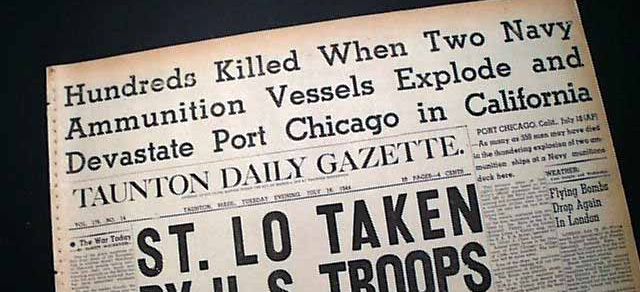
The Port Chicago Disaster and Its Historical Impact
On July 17, 1944, crews at the magazine in the San Francisco Bay area were loading two Pacific-bound naval vessels with active munitions when the explosives ignited in a terrific series of blasts. Felt throughout the area, the explosions broke windows as far away as San Francisco, hurled debris in the air, obliterated both ships, and killed everyone at the waterfront. To this day, because of the tragedy, ignition sources for bombs and guns are loaded separately on carriers.
The disaster caused the greatest loss of life on the home front during World War II. 320 men died, and almost 400 others were injured. Of the 320 killed, 202 were African Americans.
Read the names of those who gave their lives.
In the nation’s then-segregated military, enlisted and drafted African Americans could work in kitchens, cooking meals for fellow servicemen, or as stevedores, loading and unloading ships. The stevedores at Port Chicago lacked training and thought they were handling inactive munitions. In reality, they were working at top speed to load bombs equipped with warheads.
After the explosion, African American survivors were sent to a nearby base to resume loading ships for the war effort. Many refused to continue their work without safety training, and the U.S. Navy charged 50 of these men with “conspiring to make mutiny.” They were tried, convicted, and imprisoned. After the war, they were released, granted clemency, allowed to complete their military service, and given honorable discharges. Only one was ever pardoned.
Thurgood Marshall, Chief Consul for the National Association for the Advancement of Colored People (NAACP), attended the trial and took advantage of the occasion it presented to speak with journalists several times about racial discrimination in the armed forces. The Navy began to integrate its regiments in June 1945. Desegregation of the entire U.S. military came in 1948.
Port Chicago Naval Magazine National Memorial reminds Americans that our history includes both opposition to injustice—opposition seen here in the actions of Thurgood Marshall—and the tolerance of injustice in such forms as segregation. The story of Port Chicago resonates with any group whose members have been treated differently from other citizens of their country. The story also raises questions—who in our world is treated as being of lesser worth? who is denied opportunities?—and motivates us to strive for the equality of all.